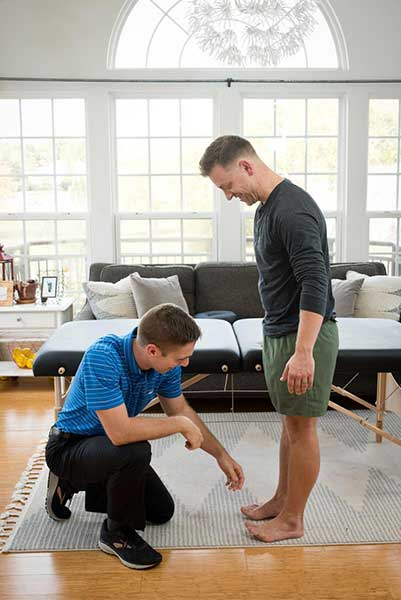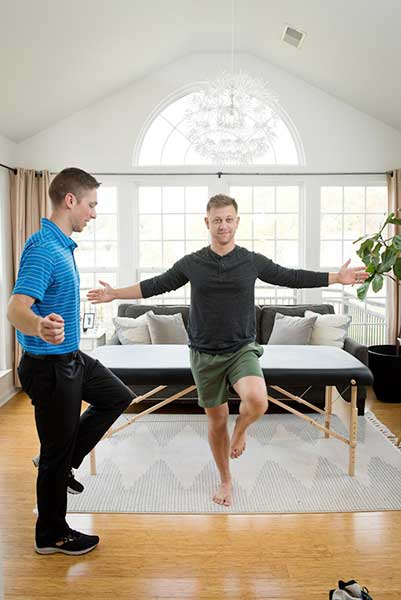Why do some people have such great balance and coordination, while others appear clumsy and unsteady? For example, gymnasts and martial artists seem to move so gracefully – how do they do it?
The good news is that most of us don’t need that level of balance to keep up our families and complete our day-to-day activities. However, poor balance is actually a red flag for numerous potential issues and impairments.
Having poor balance is common and gets worse as we age. Although it may seem normal and insignificant, the biggest concern with a poor balance is suffering a potentially serious injury from stumbling or falling.
How do you know if you have poor balance? Signs such as an inability to walk in a straight line, inability to put on pants while balancing on one leg, trouble standing with your feet together and eyes closed, or frequently bumping into things are all suggestive of a balance issue that merits further investigation.
So what causes the balance to deteriorate? There are numerous causes that can be associated with impaired balance. Some common causes include:
1. Deterioration in Physical Fitness and Deconditioning
Even with a good fitness routine, our muscle mass decreases with age. However, without a normal exercise regimen, it can affect people of any age. Many jobs promote sedentary lifestyle habits, and a lack of a focus on consistent strengthening and aerobic conditioning takes its toll. In particular, a loss of strength in the hip muscles and your trunk/core can make it difficult to reorient your body when needed for good balance. If a person does not challenge these hip and core muscles often enough with exercise, it will eventually lead to a loss of strength and muscle mass. Thus, a proper exercise prescription and dosage can help avoid or minimize this deterioration in physical fitness.

2. Inner Ear Disorders
The vestibular system is the part of the inner ear involved with balance. When the vestibular system is healthy, it gathers information relating to motion, spatial orientation, and equilibrium. This information is then sent to the brain, which in turn adjusts and controls eye and postural muscles accordingly. In the case of a healthy vestibular system, symmetrical impulses from both ears are sent to the brain and everything functions properly. However, an improperly functioning vestibular system results in asymmetrical impulses and issues with sensory information sent to the brain. This type of vestibular dysfunction causes individuals to feel dizzy and disoriented. One of the most common vestibular disorders is vertigo (benign paroxysmal vertigo or BPPV). BPPV is triggered by head movements in which loose particles in the inner ear cause dizziness, vertigo (spinning), lightheadedness, and nausea. A specialty-trained vestibular physical therapist can effectively treat this condition relatively quickly. There are several other types of vestibular disorders as well, and many of them can be successfully treated with specialized vestibular therapy aimed at helping the body compensate for the loss of accurate vestibular input.
3. Impaired Visual Acuity (Bad Eyesight)
Good vision helps us maintain a steady focus on things in our environment. If you are unable to maintain this focus, especially when you are moving, it can cause a feeling of disorientation and poor balance. If you notice signs of deteriorating vision (increasing difficulty reading road signs, blurred vision, getting headaches from reading, etc.), contact an optometrist for an eye exam. The solution could be as simple as an updated prescription or new corrective lenses. It could also involve vestibular therapy designed to help your eyes track more smoothly and focus more effectively.

4. Nerve Damage
Peripheral neuropathy in the lower extremities results from damage to the nerves that send information from your brain and spinal cord to the legs and feet, which can also cause balance difficulties. This manifests itself in the form of areas of “numbness” or decreased sensation in the feet. Diabetes is one of the most common causes of peripheral neuropathy. However, peripheral neuropathy is also associated with certain autoimmune diseases, trauma, infection, medications, alcoholism, and nutrient deficiencies. Consult your physician or physical therapist for more information on possible causes of any numbness or tingling in your feet.

5. Neurological Disorders
Various neurological disorders can also lead to balance problems. For example, vertigo (dizziness with a feeling that the room is spinning) could be a sign of a stroke if it is sudden and combined with other stroke symptoms such as weakness, numbness, vision problems or speech problems. This should be considered a medical emergency and you should call 911 if you are ever experiencing these symptoms in combination. Parkinson’s disease can also cause balance problems due to the effects on the ability of the brain to process signals from the peripheral nervous system. Dementia is another common cause of balance problems, as it essentially causes a disconnect between sensory signals and awareness in space.
There are certainly other causes of impaired balance, many of which are treatable. If you or someone you know has poor balance, do not ignore it and wait for an eventual traumatic injury to occur.
The therapists at Limitless Therapy and Wellness are specially trained to diagnose and treat a wide variety of balance issues and get you back to moving safely and gracefully.




